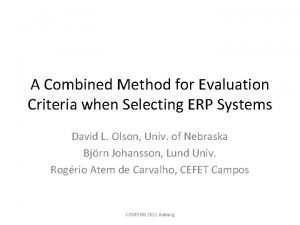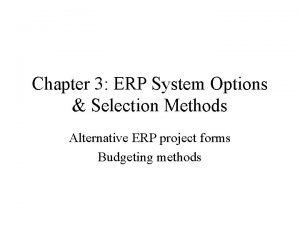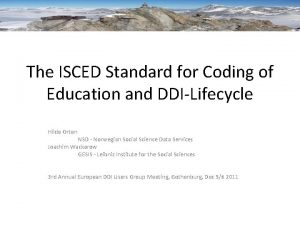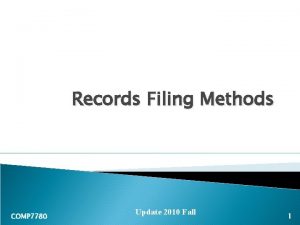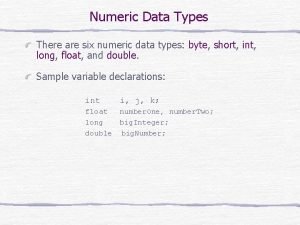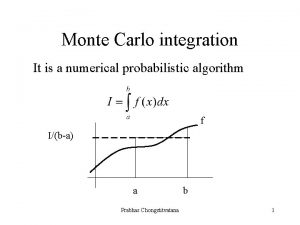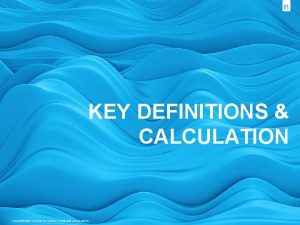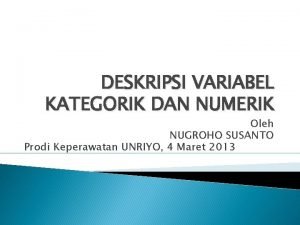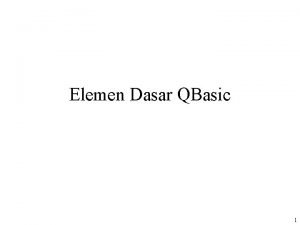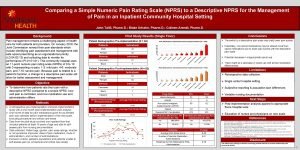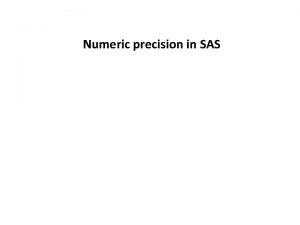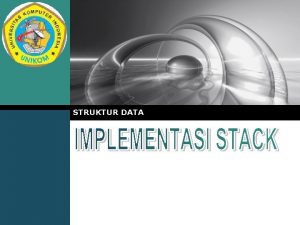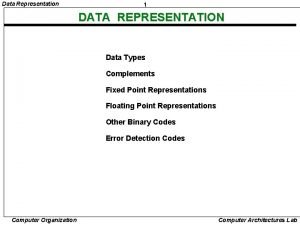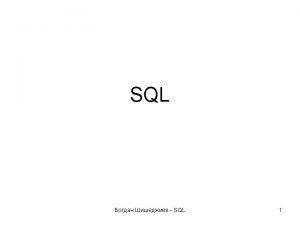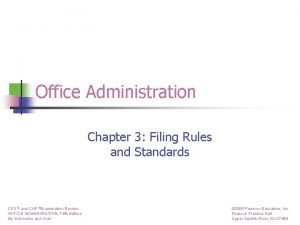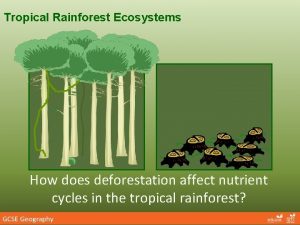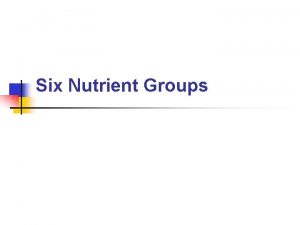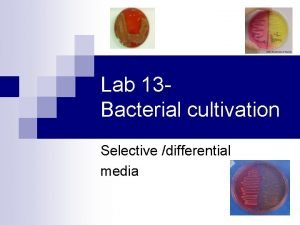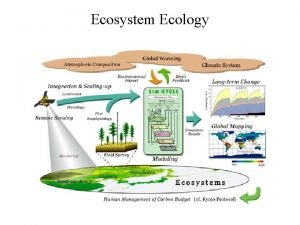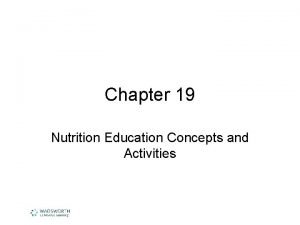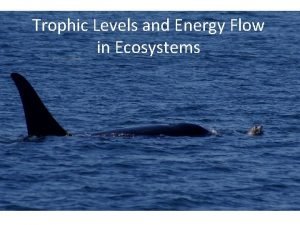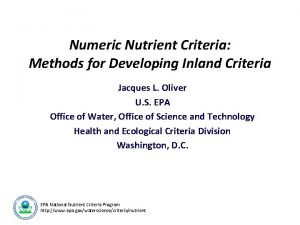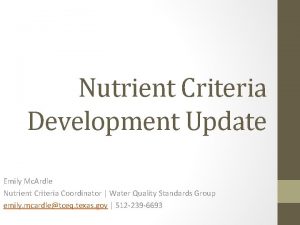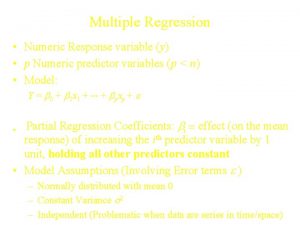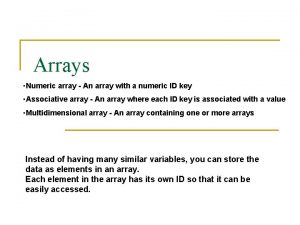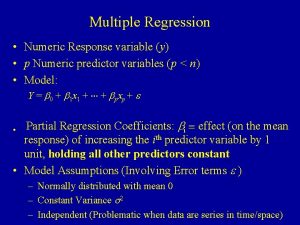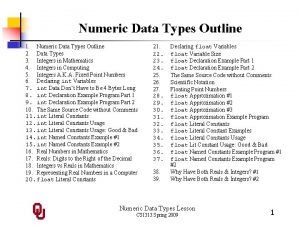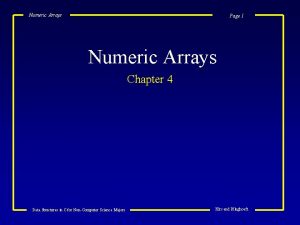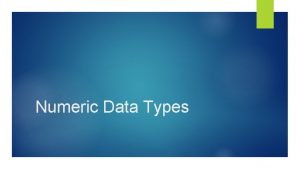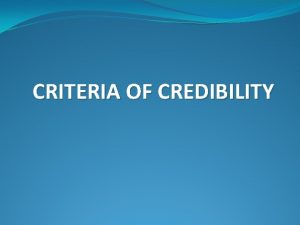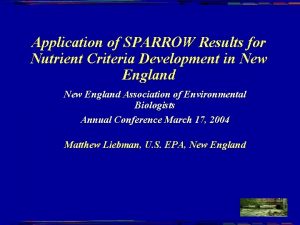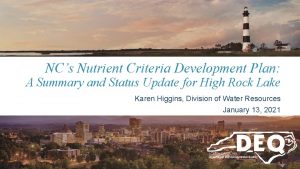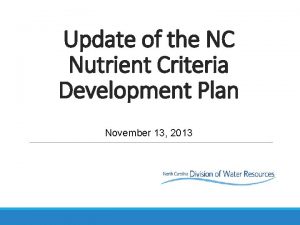Methods for Development of Numeric Nutrient Criteria Lessons





































- Slides: 37

Methods for Development of Numeric Nutrient Criteria: Lessons from Florida Estuaries James D. Hagy III US EPA NHEERL Gulf Ecology Division Gulf Breeze, FL National Water Quality Monitoring Council Feb 1 -3, 2011, Pensacola Beach, FL

Overview • Legal and Policy Background • Biological Endpoints • Using Water Quality Simulation Models to Develop Criteria for Estuaries • Using Satellite Remote Sensing to Develop Criteria for Offshore Coastal Waters • Using Watershed Models to Compute Downstream Protection Criteria 1

Clean Water Act Context • Clean Water Act Objective “… Restore and maintain the chemical, physical, and biological integrity of our Nation’s waters. ” - Section 101(a) • Clean Water Act Goal “It is the national goal that wherever attainable, an interim goal of water quality which provides for the protection and propagation of fish, shellfish, and wildlife and provides for recreation in an on the water be achieved …” - Section 101(a)(2) 2

Narrative Nutrient Criteria For Florida Waters Florida’s estuaries and coastal waters are protected from nutrient enrichment by an existing narrative standard (62 -302. 530(47)(b), FAC), which provides in part: “In no case shall nutrient concentrations of a body of water be altered so as to cause an imbalance in natural populations of aquatic flora or fauna. ” Narrative criterion is currently interpreted waterbody by waterbody: - time consuming - labor intensive - process generally applied to impaired waters 3

The Determination • In 2009, EPA determined that numeric criteria were needed for Florida waters to meet the requirements of the CWA. • Numeric criteria will expedite implementation and assure attainment of designated uses in both impaired waters and high-quality waters. • EPA’s focus is to translate the existing narrative into measurable numeric criteria. 4

Part 1: Translating the Narrative Biological Endpoints Qualitative Statements Ecological Indicators Numeric Criteria Quantitative Measures Quantitative Water Quality Measures 5

Translating the Narrative: Some Terminology “In no case shall nutrient concentrations of a body of water be altered so as to cause an imbalance in natural populations of aquatic flora or fauna. ” (What the narrative says!) Biological Endpoint: The condition of a nutrient-sensitive aquatic life resource that is judged to reflect “balanced flora and fauna. ” (What the narrative is believed to mean, in part, in Florida estuaries. ) Indicator Variables: Quantitative measures that point to the status of biological endpoints and which can be related quantitatively to criteria. (How criteria quantitatively relate to endpoints) Numeric Criteria: Concentrations or levels of TN and TP and nutrient-related response variables that, if achieved, provide a reasonable expectation that designated uses will be supported. (These are the values that go into the regulation. ) 6

Conceptual Model of Nutrient Effects Healthy condition. Normal phytoplankton condition. Light not reduced due to nutrient enrichment. Seagrasses grow to historically-supported depth. Oxygen not depleted. Nutrient-impaired. Increased phytoplankton production & biomass. Light field reduced, degrading seagrass. Oxygen may become reduced, especially in stratified waters, impairing marine life. 7

Translating the Narrative: A Seagrass Example “… an imbalance in natural populations of aquatic flora or fauna. ” Biological Endpoint: Seagrasses habitats and associated communities are healthy and may have a distribution similar to the historical distribution (Are populations “balanced” if key population is absent because of nutrient enrichment? ) Indicator Variables: Depth of colonization. Relates quantitatively to water clarity, and WQ conditions that impact clarity (e. g. , chlorophyll-a). Numeric Criteria: TN, TP, chlorophyll-a limited to levels consistent with sustaining seagrass at depth of colonization target. 8

Translating the Narrative: “Balanced Fauna” “… an imbalance in natural populations of aquatic flora or fauna. ” Biological Endpoint: An normal assemblage of faunal species may utilize the waterbody (i. e. , not limited by nutrient enrichment). If significant component of faunal community is likely absent, system may be “imbalanced. ” Indicator Variables: Dissolved oxygen (hypoxia). Scientific data provide a clear relationship between hypoxia and absence of hypoxia-sensitive taxa from estuaries. Numeric Criteria: TN, TP, chlorophyll-a limited to levels consistent with prevention of hypoxia caused by anthropogenic nutrient-enrichment. 9

Translating the Narrative: “Balanced Algal Community” “… an imbalance in natural populations of aquatic flora or fauna. ” Biological Endpoint: Algal biomass and species composition supports normal, healthy ecosystem function and productivity. (OK, this one is harder!) Indicator Variables: Chlorophyll-a, phytoplankton species composition (limited data) within range locally associated with healthy ecosystem function (“squishier” … draw on local expert opinion? ) Numeric Criteria: TN, TP limited to levels associated with healthy chlorophyll-a levels (could require a “reference condition” approach) 10

Path of Ecological Causation Chlorophyll-a Causal Variables (TN, TP Loading) Ecological Indicators TN, TP Conc. Healthy Seagrasses Depth of Colonization (Water Clarity) Balanced Phytoplankton Dissolved Oxygen Balanced Faunal Communities Ecological Indicators Biological Assessment Endpoints 11

Working “Backwards” for Criteria Development Observed Water Quality (TN, TP, Chl-a) Reference Condition Approach Ecological Models Causal Variables (TN, TP Loading) TN, TP Conc. Chlorophyll-a Depth of Colonization (Water Clarity) Dissolved Oxygen Ecological Indicators Healthy Seagrasses Balanced Phytoplankton Balanced Faunal Communities Biological Assessment Endpoints 12

Translating the Narrative Criteria: Summary • Preferred approach is linking CWA act goal (or narrative) to biological endpoints that relate to quantitative indicators and subsequently to numeric criteria. • Certain ecological situations provide relatively obvious endpoints, whereas others do not. • Getting this part right may impart greater clarity and focus to the rest of the effort. • Data availability can limit consideration of endpoints that otherwise might be useful (e. g. , macroalgae, epiphytic algae) • For other states, this aspect of numeric criteria development may be helped or further hindered by each state’s existing designated uses and any narrative criteria. 13

Part 2: Ecological Models in Criteria Development • Ecological models relate quantitative goals for ecological indicators to numeric criteria values. • Regression models, Simulation Models • May need to address both average condition and variability. • Best model depends on ecological factors and data availability. • Sound scientific rationale may incorporate information from several different types of models. • Mechanistic simulation models, or “Water Quality Models” will likely be important tools. 14

Water Quality Models for Criteria Development • WQM used extensively in water quality management, especially impaired waters (TMDLs) • WQM are likely to be useful for numeric criteria development. Especially if: • Interactions complex, physical-biological coupling, range of temporal/spatial scales. • Processes are well-understood. • Process-oriented data • Available data are concentrated in a few years. 15

Limitations of Water Quality Models • WQM can’t tell you what the endpoint should be! • WQM can’t simulate processes that aren’t included in the model. • Simulating “regime shift” • WQM can be astoundingly good … and also not very good. • Even bad models make pretty pictures. • Even good models fail sometimes. • The model doesn’t simulate _____. Adding _____ doesn’t always help. 16

Strengths of Water Quality Models • WQM bring different kinds of information together … they “connect the dots. ” • WQM may provide information about not only average response, but range of response. • WQM explicitly address displacement of ecological responses in time and space. • WQM characterize all the variables, not just the target variable. • WQM answer the kinds of questions we need to ask. 17

Example using Watershed /Water Quality Models • Environmental Fluid Dynamics Code (EFDC) Pensacola Bay EFDC/WASP Model Grid, coupled with watershed model. Background Load coupled with Water Quality Analysis Simulation Program (WASP) • Simulate indicators such as water clarity, chlorophyll-a, DO • Quantify relationship between load and response and among variables. • Existing load scenario, background load scenario, compliance scenario. Indicator Achieves Target Current Loading (Calibration) 18

WQM for the 2010 s … Some predictions • There will eventually be models simulating WQ for every mile of US coastline. • People will continue to pay attention to models. • “Best practices” for modeling will accelerate progress and improve standing of modeling in scientific community. • Modeling “best practices” will entail more open and effective communication of models and model results. Transparency is essential. • Modeling will make monitoring more useful. Monitoring will make modeling harder. 19

Part 3: Reference Condition Approach for Coastal Waters using Satellite Remote Sensing • Coastal waters, 0 -3 NM from • • Remote Sensing Analysis by Dr. Blake Schaeffer, US EPA, GED shore Few segments classified as impaired due to nutrients, May be “attaining uses. ” Reference condition approach could be used to protect high quality waters from future impairment. Limited “field-collected” water quality data.

Reference Condition Approaches • Probably the most thoroughly discussed approach for developing numeric criteria. • Historical Reference Condition: Data available from a minimally-impacted reference period. • Comparative Reference Condition: Similar estuary has data for a minimally-impacted reference period. • “Use attaining” Reference Approach – • Special case of historical reference period for high quality waters. • Existing water quality defines the reference condition. • Common Element: Criteria based on a statistic derived from the distribution of WQ during the reference period. 21

Remote Sensing Approach • Daily ocean color imagery for entire coast • Sea. Wi. FS (9/97 – 1/1/10) • MODIS (6/02 – present) • Remotely-sensed indicator called “Chl. RS-a. ” • 8 -day segment averages quantify 40 of 76 segments each week with QA exclusions. • “Black out” areas with known interferences from (1) bottom reflectance and (2) CDOM • Ground-truth with field-collected data illustrating relationship between RS data and field data in target area. • Calculate Medians and 75 th Percentiles in 3 year assessment windows. • Criteria based on highest expected values within the reference period. 22

What about Karenia brevis? • Satellites detect K. brevis cell counts above 50, 000 cells/L • Use field-based monitoring (FWRI) for K. brevis to establish “KB flag. ” 3. 14 3. 57 • Examine reference values with and without K. brevis. • Although K. brevis blooms are important concern, impact on Chl. RS-a distribution not large. 23

Coastal Criteria - Summary • Satellite remote sensing provides an outstanding data set for application of reference condition approach to otherwise data-poor areas of Florida coast. • RS-based numeric criteria can be assessed in the future using RS. • Intercomparison of Sea. Wi. FS, MODIS, MERIS sensors. • TN and TP criteria not addressed; causal analysis 24

Part 4: Numeric Nutrient Criteria for Protection of Downstream Estuaries • TN and TP criteria that protect streams may not ensure protection of estuaries. • 0. 47 mg/L. 0. 67 mg/L. +42% • 40 CFR 131. 10(b) requires that criteria provide for the attainment and maintenance of water quality standards of downstream waters. • DPVs as “Loading Criteria” • Computing DPVs throughout watersheds. 25

DPVs in EPA’s 2010 Proposed Rule Stream reaches "binned" according to estimated delivery fraction. DPV calculated for each FD range Concentration at "pour point" 26

Outflow of reach i. Computing DPVs “Protective Loading Rate” Avg Streamflow Terminal Reach or “Pour Point” Concentration Avg “Fraction. Delivered” DPV for Upstream Reach Terminal Node 27

Watershed Models • Loading Simulation Program in C++ (LSPC) • Simulates daily stream flow, velocity, plus TN, TP. • Can calculate expected TN and TP retention or loss in stream network. • First-order loss model; extrapolates understanding of loss rate to the largescale/long-term average result. Days Average Time of Travel to Estuary 28

First-Order Loss Rate for Total Nitrogen • TN loss rate generally decreases with stream depth, but with considerable variability. • Also decreases with stream discharge (deeper streams usually have higher discharge). • Empirical estimates from South Atlantic/Gulf/Tennessee SPARROW model (Hoos and Mc. Mahon 2009). Avg. Q (m 3 s-1) k (day-1) < 28 m 3 s-1 0. 14± 0. 05 > 28 m 3 s-1 0. 014± 0. 02 First-Order Decay of NO 3 - Bohlke et al. 2009 29

Computed TN Fraction-Delivered • Fraction-delivered depends on approach for specifying k. TN. • Values generally between 0. 5 and 1. 0. • Using constant k. TN=0. 14 d-1, fraction-delivered corresponds directly to time-of travel (A) • Fraction-delivered higher along larger streams and rivers using flowdependent k. TN (B) 30

Fraction Delivered (k. TN ± s. d. ) Dependence of Fraction Delivered on TN Loss Rate (k. TN) k. TN=[0. 09, 0. 012] k. TN=[0. 19, 0. 016] • Uncertainty due to TN loss rate estimates from SPARROW is ± 10% on longest, slowest flow paths. • Uncertainty decreases as timeof-travel decreases. Fraction Delivered (SPARROW Rates) 31

Computation of TN DPVs • Differing “terminal reach” criteria … create “zones. ” • Reduce number of DPVs by “binning” FD values. • Hypothetical application with 3 “zones” creates 12 DPVs. • Recently promulgated stream criteria for TN limits P’cola streams to 0. 67 mg N L-1. • If DPVs become very high due to low fraction-delivered, IPVs will apply. Current TN~0. 4 -0. 5 mg/L 32

Total Phosphorus Retention • TP is “retained” in watersheds rather than “lost. ” • Different perspectives on P retention in stream networks: • Permanent P retention in streams is minimal; P accumulates only in lakes and reservoirs along the flow-path. • P is retained in shallower channels and is transported in deeper channels. Leads to dynamic similar to nitrogen. • TP SPARROW model for southeast region estimates first-order loss (i. e. , retention) parameter (d-1) as: where z (meters), supporting second approach. TP Fraction-Delivered based on k. TP from SPARROW model. 33

Computation of TP DPVs • Similar approach as for TN… • “terminal reach zones. ” • Reduce number of DPVs by “binning” FD values. • Hypothetical application with 3 “zones” creates 9 DPVs. • Applicable IPV for TP is 0. 06 mg/L, 320% of current TP. Current TP~0. 018 34

Sunshine Skyway Bridge Spans the Mouth of Tampa Bay 35

Florida’s Estuaries and Coastal Waters 1 2 3 4 5 7 8 9 10 11 12 13 14 15 16 17 18 19 20 21 22 24 25 26 27 28 29 Perdido Bay Pensacola Bay Choctawhatchee Bay St. Andrews Bay St. Joseph Bay Apalachicola Bay Alligator Harbor Ochlockonee Bay Big Bend/Apalachee Bay Suwannee Sound/Cedar Keys Springs Coast Clearwater Harbor/St. Joseph Sound Tampa Bay Sarasota Bay Charlotte Harbor Rookery Bay / Southwest Shelf (South) Florida Keys (South) Florida Bay (South) Biscayne Bay, Barnes Snd, Card Snd (South) Lake Worth Lagoon / Loxahatchee Bay St. Lucie Estuary Indian River Lagoon Halifax River Guana, Tolomato, Matanzas, Pellicer St. John’s River Estuary Nassau River / Big Talbot St. Marys River / Amelia River 1 2 3 4 5 7 9 8 29 28 10 27 26 11 25 12 13 24 14 15 22 16 21 17 20 19 18 36
 Peptone water
Peptone water Erp selection methods and criteria
Erp selection methods and criteria Erp system options and selection methods
Erp system options and selection methods Indirect methods of contoring uses how many methods
Indirect methods of contoring uses how many methods Isced codes
Isced codes Geographic filing system example
Geographic filing system example Numeric data types in java
Numeric data types in java Numeric outline
Numeric outline Numeric integral
Numeric integral Numeric distribution vs weighted distribution nielsen
Numeric distribution vs weighted distribution nielsen Numeric function in discrete mathematics
Numeric function in discrete mathematics Numeric expression example
Numeric expression example Apa itu variabel numerik
Apa itu variabel numerik Python numbers.number
Python numbers.number Numeric constant in qbasic
Numeric constant in qbasic Numeric indicator
Numeric indicator Numeric data representation
Numeric data representation Numeric pain rating scale nprs
Numeric pain rating scale nprs Alphabet number code
Alphabet number code Clustering non numeric data
Clustering non numeric data Quiet wrists and elbows
Quiet wrists and elbows Sas numeric precision
Sas numeric precision Contoh infix
Contoh infix Disadvantages of output devices
Disadvantages of output devices Data representation types
Data representation types Sqlite numeric type
Sqlite numeric type Straight numeric filing
Straight numeric filing Numeric expression
Numeric expression Wrist joint blood supply
Wrist joint blood supply How does deforestation affect the nutrient cycle
How does deforestation affect the nutrient cycle Nnn plant protein
Nnn plant protein Differential media
Differential media Egg emulsifier recipes
Egg emulsifier recipes Nutrient cycle in the serengeti
Nutrient cycle in the serengeti Deciduous woodlands
Deciduous woodlands Foods used in nutrition activities should be nutrient-dense
Foods used in nutrition activities should be nutrient-dense Bray nutrient mobility concept
Bray nutrient mobility concept Nutrient chain foldable
Nutrient chain foldable

